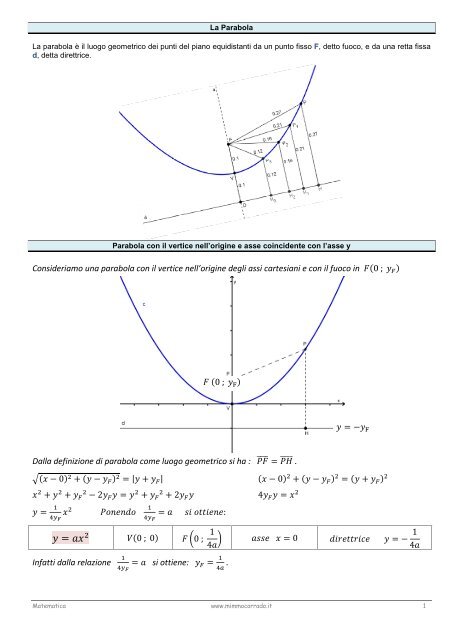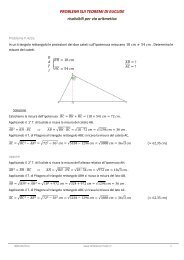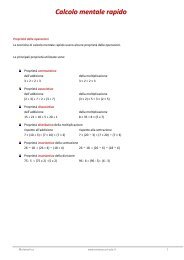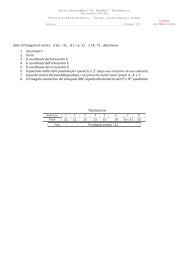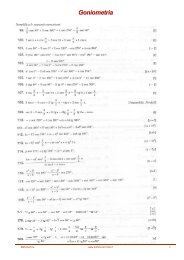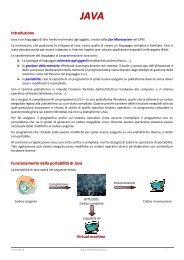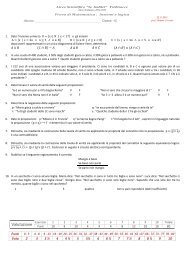Consideriamo una parabola con il vertice nell ... - Mimmo Corrado
Consideriamo una parabola con il vertice nell ... - Mimmo Corrado
Consideriamo una parabola con il vertice nell ... - Mimmo Corrado
Create successful ePaper yourself
Turn your PDF publications into a flip-book with our unique Google optimized e-Paper software.
La Parabola<br />
La <strong>parabola</strong> è <strong>il</strong> luogo geometrico dei punti del piano equidistanti da un punto fisso F, detto fuoco, e da <strong>una</strong> retta fissa<br />
d, detta direttrice.<br />
Parabola <strong>con</strong> <strong>il</strong> <strong>vertice</strong> <strong>nell</strong>’origine e asse coincidente <strong>con</strong> l’asse y<br />
<strong>Consideriamo</strong> <strong>una</strong> <strong>parabola</strong> <strong>con</strong> <strong>il</strong> <strong>vertice</strong> <strong>nell</strong>’origine degli assi cartesiani e <strong>con</strong> <strong>il</strong> fuoco in 0 ; <br />
Dalla definizione di <strong>parabola</strong> come luogo geometrico si ha : = .<br />
− 0 + − = | + | − 0 + − = + <br />
+ + − 2 = + + 2 4 = <br />
= <br />
<br />
<br />
<br />
= :<br />
<br />
= 0 ; 0 0 ; 1<br />
1<br />
= 0 = −<br />
4 4<br />
Infatti dalla relazione <br />
<br />
0 ; <br />
= si ottiene: = <br />
.<br />
= − <br />
Matematica www.mimmocorrado.it 1
Parabola <strong>con</strong> asse parallelo all’asse y (dimostrazione 1)<br />
<strong>Consideriamo</strong> la <strong>parabola</strong> = <strong>con</strong> <strong>il</strong> <strong>vertice</strong> <strong>nell</strong>’origine e asse coincidente <strong>con</strong> l’asse .<br />
Trasliamo la <strong>parabola</strong> portando <strong>il</strong> <strong>vertice</strong> nel punto ; .<br />
Le equazioni della traslazione sono : ′ = + ′ = + Sostituendo le equazioni inverse: = ′ − <strong>nell</strong>’equazione della <strong>parabola</strong> = <br />
= ′ − si ottiene<br />
l’equazione della <strong>parabola</strong> <strong>con</strong> <strong>vertice</strong> nel punto ; .<br />
′ − = − ; ′ − = + − 2 ; ′ = − 2′ + + <br />
Ponendo: = −2 <br />
si ottiene l’equazione : ′ = <br />
= + <br />
<br />
+ ′ + .<br />
Dalla relazione: = −2 si ricava : = − <br />
2<br />
Essendo <strong>il</strong> fuoco e <strong>il</strong> <strong>vertice</strong> appartenenti<br />
entrambi all’asse risulta :<br />
Dalla relazione: = + si ha:<br />
<br />
= − + = − −<br />
2 <br />
<br />
= − <br />
2<br />
+ = − ∆<br />
+ = − + = −<br />
4 4 <br />
Dall’equazione della traslazione ′ = + si ha:<br />
′ = + = 1 ∆ 1 − ∆<br />
+ − =<br />
4 4 4<br />
′ = + = − 1 ∆ 1 + ∆<br />
+ − = −<br />
4 4 4<br />
Riassumendo : = + + <br />
è l'equazione di <strong>una</strong> <strong>parabola</strong> <strong>con</strong> :<br />
<br />
− <br />
2<br />
− <br />
2<br />
; <br />
<br />
= −<br />
2<br />
∆<br />
<br />
; − : = −<br />
4 2<br />
1 − ∆<br />
1 + ∆<br />
; : = −<br />
4 4<br />
Matematica www.mimmocorrado.it 2
Parabola <strong>con</strong> asse parallelo all’asse y (dimostrazione 2)<br />
<strong>Consideriamo</strong> nel sistema di riferimento <strong>una</strong> <strong>parabola</strong> <strong>con</strong> <strong>il</strong> <strong>vertice</strong> nel punto ; e <strong>con</strong> asse<br />
di simmetria parallelo all’asse y .<br />
La <strong>parabola</strong>, nel sistema di riferimento <strong>con</strong> l’origine coincidente <strong>con</strong> <strong>il</strong> <strong>vertice</strong> V della <strong>parabola</strong> e gli assi<br />
paralleli ed equiversi ai vecchi assi, ha equazione: = <br />
0 ; 0 0 ; 1<br />
1<br />
: = − : = 0<br />
4 4<br />
Per trovare l’equazione della <strong>parabola</strong> nel vecchio sistema di riferimento operiamo <strong>una</strong> traslazione di<br />
assi di equazione: = − = − − = − − = + − 2<br />
= − 2 + + <br />
<br />
Ponendo: = −2 <br />
si ottiene l’equazione : = <br />
= + <br />
+ + .<br />
= + + <br />
è l' equazione di <strong>una</strong> <strong>parabola</strong> <strong>con</strong> :<br />
Infatti, dalla relazione: = −2 si ricava:<br />
= − <br />
2 = − <br />
2<br />
− <br />
2<br />
− <br />
2<br />
∆<br />
<br />
; − : = −<br />
4 2<br />
1 − ∆<br />
1 + ∆<br />
; : = −<br />
4 4<br />
= − <br />
2<br />
Dalla relazione: = + si ricava: = − + = − − <br />
<br />
Dall’equazione della traslazione = − si ha: = + dalla quale si ottiene:<br />
= + = 1 ∆ 1 − ∆<br />
− =<br />
4 4 4<br />
= + = − 1 ∆ 1 + ∆<br />
− = −<br />
4 4 4<br />
<br />
; <br />
+ = − <br />
<br />
∆<br />
+ = − + = −<br />
<br />
Matematica www.mimmocorrado.it 3
Parabola <strong>con</strong> asse parallelo all’asse y (dimostrazione 3)<br />
La <strong>parabola</strong> è <strong>il</strong> luogo geometrico dei punti del piano equidistanti da un punto fisso, detto fuoco, e da <strong>una</strong> retta fissa,<br />
detta direttrice.<br />
Siano: ( x ; )<br />
F <strong>il</strong> fuoco, d<br />
F yF<br />
Dalla definizione si ha: PF = PH .<br />
2<br />
2<br />
( x x ) + ( y − y ) = y − d<br />
− ;<br />
F<br />
( ) ( ) ( ) 2<br />
2<br />
2<br />
x x + y − y = y − d<br />
2<br />
− ;<br />
F<br />
F<br />
2<br />
F<br />
F<br />
F<br />
2<br />
2<br />
F<br />
y = la direttrice e ( x;<br />
y )<br />
x − 2x<br />
x + x + y + y − 2y<br />
y = y − 2dy<br />
+ d ;<br />
x<br />
2<br />
2<br />
F<br />
2<br />
F<br />
− 2x<br />
x + x + y − 2y<br />
y = d − 2dy<br />
;<br />
F<br />
F<br />
2<br />
F<br />
F<br />
2<br />
F<br />
F<br />
2<br />
2<br />
F<br />
2 dy − 2y<br />
y = −x<br />
+ 2x<br />
x − x − y + d ;<br />
F<br />
2<br />
F<br />
2<br />
F<br />
2<br />
F<br />
2y y − 2dy<br />
= x − 2x<br />
x + x + y − d ;<br />
2<br />
2 2 2<br />
( y d)<br />
⋅ y = x − 2x<br />
x + x + y d<br />
2 − − ;<br />
F<br />
y =<br />
2<br />
1<br />
x<br />
2<br />
x<br />
F<br />
( y − d ) y − d 2(<br />
y − d )<br />
F<br />
Ponendo:<br />
−<br />
F<br />
F<br />
⎧ 1<br />
⎪ = a<br />
⎪2(<br />
yF<br />
− d )<br />
⎪ xF<br />
⎨−<br />
= b<br />
⎪ yF<br />
− d<br />
⎪ 2 2<br />
x + y − d<br />
⎪ F F<br />
⎪⎩<br />
2(<br />
yF<br />
− d )<br />
2<br />
F<br />
x<br />
x +<br />
= c<br />
2<br />
F<br />
F<br />
+ y<br />
F<br />
2<br />
2<br />
F<br />
2<br />
2<br />
− d<br />
Infatti, ricavando le formule inverse si ha:<br />
⎧ 1<br />
⎪yF<br />
− d =<br />
2a<br />
⎪<br />
⎨−<br />
⎪−<br />
⎪<br />
⎩<br />
⎧ xF<br />
⎪−<br />
= b<br />
1<br />
⎪<br />
2a<br />
⎨ 2 2 2<br />
⎪ xF<br />
+ yF<br />
− d<br />
= c<br />
⎪ 1<br />
⎪ 2 ⋅<br />
⎩ 2a<br />
⎧ b<br />
⎪xF<br />
= −<br />
2a<br />
⎪<br />
2 2<br />
⎨ xF<br />
+ yF<br />
− d<br />
⎪ 1<br />
⎪<br />
⎩ a<br />
2<br />
2<br />
P un punto della <strong>parabola</strong>.<br />
2<br />
2<br />
si ottiene: y = ax + bx + c <strong>con</strong><br />
2<br />
⎛ b Δ ⎞<br />
V ⎜−<br />
; − ⎟<br />
⎝ 2a<br />
4a<br />
⎠<br />
⎛ b 1 − Δ ⎞<br />
F ⎜−<br />
; ⎟<br />
⎝ 2a<br />
4a<br />
⎠<br />
1 + Δ<br />
d : y = −<br />
4a<br />
b<br />
a : x = −<br />
2a<br />
Matematica www.mimmocorrado.it 4<br />
= c<br />
⎧<br />
⎪x<br />
⎨<br />
⎪x<br />
⎪⎩<br />
F<br />
2<br />
F<br />
b<br />
= −<br />
2a<br />
⎛ b ⎞ 2 2 c<br />
2 2 b c<br />
⎜−<br />
⎟ + yF<br />
− d = ; yF d = − + 2<br />
⎝ 2a<br />
⎠<br />
a<br />
4a<br />
a<br />
4a<br />
⎧ 1<br />
Δ<br />
1 ⎪y<br />
F − d =<br />
2a<br />
( y F + d ) ⋅ ( y F − d ) = − ma y d<br />
2<br />
F − = ⇒ ⎨<br />
4a<br />
2a<br />
⎪ 1 Δ<br />
( y + ) ⋅ = −<br />
⎪ F d<br />
2<br />
⎩ 2a<br />
4a<br />
1 Δ 1 − Δ<br />
Sommando membro a membro si ha: 2y F = − ; yF =<br />
2a<br />
2a<br />
4a<br />
Δ 1 1 + Δ<br />
Sottraendo membro a membro si ha: 2d = − − ; d = −<br />
2a<br />
2a<br />
4a<br />
L’ascissa del <strong>vertice</strong> è uguale all’ascissa del fuoco.<br />
L’ordinata del <strong>vertice</strong> è:<br />
y<br />
V<br />
+ y<br />
2<br />
F<br />
− d<br />
2<br />
=<br />
c<br />
a<br />
sostituendo x F <strong>nell</strong>a II a<br />
2<br />
2<br />
2 2 − b + 4ac<br />
2 2 Δ<br />
− ; yF<br />
− d =<br />
; y<br />
2<br />
F d = − 2<br />
2<br />
2<br />
2<br />
⎧<br />
⎪y<br />
⎨<br />
⎪y<br />
⎪⎩<br />
− ;<br />
4a<br />
F<br />
F<br />
1<br />
− d =<br />
2a<br />
Δ<br />
+ d = −<br />
2a<br />
⎛ b ⎞ ⎛ b ⎞ b b b − 2b<br />
+ 4ac<br />
− b + 4ac<br />
Δ<br />
= a⎜−<br />
⎟ + b ⋅ ⎜−<br />
⎟ + c = − + c =<br />
=<br />
= − .<br />
⎝ 2a<br />
⎠ ⎝ 2a<br />
⎠ 4a<br />
2a<br />
4a<br />
4a<br />
4a<br />
2<br />
2<br />
2
Parabola <strong>con</strong> asse parallelo all’asse x<br />
Con procedimento analogo seguito per la <strong>parabola</strong> <strong>con</strong> asse parallelo all’asse y si ottiene l’equazione della <strong>parabola</strong><br />
<strong>con</strong> asse parallelo all’asse x.<br />
2<br />
x = ay + by + c<br />
<strong>con</strong><br />
⎛ Δ<br />
b ⎞<br />
V ⎜−<br />
; − ⎟<br />
⎝ 4a<br />
2a<br />
⎠<br />
⎛1<br />
− Δ b ⎞<br />
F ⎜ ; − ⎟<br />
⎝ 4a<br />
2a<br />
⎠<br />
1 + Δ<br />
d : x = −<br />
4a<br />
b<br />
a : y = −<br />
2a<br />
Matematica www.mimmocorrado.it 5
d<br />
2<br />
y = ax<br />
d<br />
x = −<br />
Parabola <strong>con</strong> <strong>il</strong> <strong>vertice</strong> <strong>nell</strong>’origine e asse coincidente <strong>con</strong> l’asse y<br />
a > 0<br />
y<br />
⎛<br />
F⎜0<br />
;<br />
⎝<br />
·<br />
V(0 ;0) ·<br />
V(0;0) ·<br />
1<br />
4a<br />
y<br />
1<br />
4a<br />
⎞<br />
⎟<br />
⎠<br />
y = −<br />
x<br />
1<br />
4a<br />
2<br />
y = ax<br />
V(0; 0)<br />
Parabola <strong>con</strong> <strong>il</strong> <strong>vertice</strong> <strong>nell</strong>’origine e asse coincidente <strong>con</strong> l’asse x<br />
x = ay<br />
2<br />
·<br />
a > 0<br />
⎛ 1 ⎞<br />
F⎜<br />
; 0 ⎟<br />
⎝ 4a<br />
⎠<br />
x<br />
Matematica www.mimmocorrado.it 6<br />
d<br />
x = ay<br />
2<br />
a < 0<br />
y<br />
·<br />
·<br />
⎛<br />
F⎜0<br />
;<br />
⎝<br />
a < 0<br />
·<br />
⎛ 1 ⎞<br />
F⎜<br />
; 0 ⎟<br />
⎝ 4a<br />
⎠<br />
1<br />
4a<br />
⎞<br />
⎟<br />
⎠<br />
y<br />
·<br />
V(0;0)<br />
x = −<br />
y = −<br />
d<br />
1<br />
4a<br />
x<br />
1<br />
4a<br />
x


